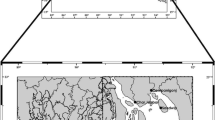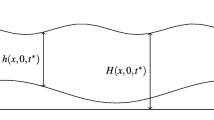Abstract
The storm surge period of 13–16 November 1977 when there was a major positive surge followed by a negative surge in the Irish Sea is investigated using a two-dimensional unstructured mesh model of the west coast of Britain. The model accounts for tidal and external surge forcing across its open boundaries which are situated in the Celtic Sea and off the west coast of Scotland. Although this period has been examined previously using a uniform finite-difference model, and a finite element model, neither of these could resolve the Mersey estuary which is the focus of the present study. By using a finite element model with very high mesh resolution within the Mersey, the spatial variability of surge elevations and currents within the Mersey to rapidly changing surge dynamics can be examined. The mesh in the model varies from about 7 km in deep water, to the order of 100 m in the Mersey, with the largest mesh length reaching 17 km in deep offshore regions, and smallest of order 26 m occurring in shallow coastal regions of the Mersey estuary. The model accounts for wetting/drying which occurs in shallow water coastal areas. Calculations showed that during the positive surge period, the amplitude and speed of propagation of the surge was largest in the deep water channels. This gave rise to significant spatial variability of surge elevations and currents within the estuary. As wind stresses decreased over the Irish Sea, a negative surge occurred over Liverpool Bay and at the entrance to the Mersey. However, within the Mersey there was a local positive surge which continued to propagate down the estuary. This clearly showed that although the large scale response of the Irish Sea to changing wind fields occurred rapidly, the response in the Mersey was much slower. These calculations with a west coast variable mesh model that included a high-resolution representation of the Mersey revealed for the first time how elevations and currents within the Mersey responded to Irish Sea surges that rapidly changed from positive to negative.














Similar content being viewed by others
References
Bernier NB, Thompson KR (2006) Predicting the frequency of storm surges and extreme sea levels in the northwest Atlantic. J Geophys Res 111:C100009. doi:10.1029/2005JC003168
Bobanovic J, Thompson KR, Desjardins S, Ritchie H (2005) Forecasting storm surges along the east coast of Canada and the northeastern U.S.: the storm of 21 January 2000. Atmos Ocean 44(2):151–161
Davies AM, Hall P (2002) Numerical problems associated with coupling models in shelf edge regions. Appl Math Model 26:807–831
Davies AM, Jones JE (1992) A three-dimensional wind driven circulation model of the Celtic and Irish Seas. Cont Shelf Res 12:159–188
Davies AM, Jones JE (1996) Sensitivity of tidal bed stress distributions, near bed currents, overtides and tidal residuals to frictional effects in the eastern Irish Sea. J Phys Oceanogr 26(12):2553–2575
Davies AM, Kwong SCM, Flather RA (2000) On determining the role of wind wave turbulence and grid resolution upon computed storm driven currents. Cont Shelf Res 20:1825–1888
Davies AM, Hall P, Howarth MJ, Knight P, Player R (2001) A detailed comparison of measured and modeled wind driven currents in the North Channel of the Irish Sea. J Geophys Res 106:19,683–19,713
Fernandes EHL, Dyer KR, Moller OO, Niencheski LFH (2002) The Patos lagoon hydrodynamics during an El Nino event (1998). Cont Shelf Res 22:1699–1713
Fernandes EHL, Marino-Tapia I, Dyer KR, Moller OO (2004) The attenuation of tidal and subtidal oscillations in the Patos Lagoon estuary. Ocean Dyn 54:348–359
Flather RA, Hubbert KP (1989) Tide and surge models for shallow water—Morecambe Bay revisited. In: Modeling marine systems. vol 1. CRC Press, Boca Raton. pp 135–166
Greenberg DA, Dupont F, Lyard FH, Lynch DR, Werner FE (2007) Resolution issues in numerical models of oceanic and coastal circulation. Cont Shelf Res 27:1317–1343
Hagen S, Westerink J, Kolar R, Horstmann O (2001) Two dimensional unstructured mesh generation for tidal models. Int J Numer Methods Fluids 35:669–686
Hagen SC, Horstmann O, Bennett RJ (2002) An unstructured mesh generation algorithm for shallow water modeling. Int J Comput Fluid Dyn 16(2):83–91
Hervouet J-M (2000) TELEMAC modelling system: an overview. Hydrol Process 14:2209–2210
Horsburgh KJ, Wilson C (2007) Tide-surge interaction and its role in the distribution of surge residuals in the North Sea. J Geophys Res Oceans 112:CO8003. doi:10.1029/2006JC004033
Jones JE (2002) Coastal and shelf-sea modelling in the European context. Oceanogr Mar Biol Annu Rev 40:37–141
Jones JE, Davies AM (1998) Storm surge computations for the Irish Sea using a three-dimensional numerical model including wave-current interaction. Cont Shelf Res 18:201–251
Jones JE, Davies AM (2005) An intercomparison between finite difference and finite element (TELEMAC) approaches to modelling west coast of Britain tides. Ocean Dyn 55:178–198
Jones JE, Davies AM (2006) Application of a finite element model (TELEMAC) to computing the wind induced response of the Irish Sea. Cont Shelf Res 26:1519–1541
Jones JE, Davies AM (2007a) Influence of non-linear effects upon surge elevations along the west coast of Britain. Ocean Dyn 57:401–416
Jones JE, Davies AM (2007b) A high resolution finite element model of the M2, M4, M6, S2, N2, K1 and O1 tides off the west coast of Britain. Ocean Model 19:70–100
Jones JE, Davies AM (2008a) On the modification of tides in shallow water regions by wind effects. J Geophys Res 113. doi: 10.1029/2007JC004310
Jones JE, Davies AM (2008b) Storm surge computations for the west coast of Britain using a finite element model (TELEMAC). Ocean Dyn 58:337–363
Jones JE, Davies AM (2010) Application of a finite element model to the computation of tides in the Mersey Estuary and eastern Irish Sea. Cont Shelf Res 30:491–514
Lane A (2004) Bathymetric evolution of the Mersey Estuary, UK, 1906–1997: causes and effects. Estuar Coast Shelf Sci 59:249–263
Legrand S, Deleersnijder E, Hanert E, Legat V, Wolanski E (2006) High-resolution, unstructured meshes for hydrodynamic models of the Great Barrier Reef, Australia. Estuar Coast Shelf Sci 68:36–46
Legrand S, Deleersnijder E, Delhez E, Legat V (2007) Unstructured, anisotropic mesh generation for the Northwestern European continental shelf, the continental slope and the neighbouring ocean. Cont Shelf Res 27:1344–1356
Levasseur A, Shi L, Wells NC, Purdie DA, Kelly-Gerreyn BA (2007) A three-dimensional hydrodynamic model of estuarine circulation with an application to Southampton Water. UK Estuar Coast Shelf Sci 73:753–767
Nicolle A, Karpytchev M (2007) Evidence for spatially variabile friction from tidal amplification and asymmetry in the Pertuis Breton Bay of Biscay, France. Cont Shelf Res 27:2346–2356
Walters RA (2005) Coastal ocean models: two useful finite element methods. Cont Shelf Res 25:775–793
Xing J, Davies AM (2001) A three-dimensional baroclinic model of the Irish Sea: formation of the thermal fronts and associated circulation. J Phys Oceanogr 31:94–114
Acknowledgments
The origin of the TELEMAC system is EDF-LNHE and is therefore ©EDF-LNHE. Thanks are due to Andrew Lane for providing accurate Mersey bathymetry. The authors are indebted to R.A. Smith for help in preparing figures and L. Parry and E. Ashton for typing the text.
Author information
Authors and Affiliations
Corresponding author
Additional information
Responsible Editor: Phil Peter Dyke
This article is part of the Topical Collection on Joint Numerical Sea Modelling Group Workshop 2010
Rights and permissions
About this article
Cite this article
Jones, J.E., Davies, A.M. Application of an unstructured mesh model to storm surge propagation in the Mersey estuary region of the Irish Sea. Ocean Dynamics 61, 933–950 (2011). https://doi.org/10.1007/s10236-011-0390-y
Received:
Accepted:
Published:
Issue Date:
DOI: https://doi.org/10.1007/s10236-011-0390-y




